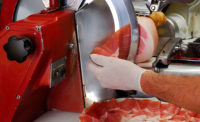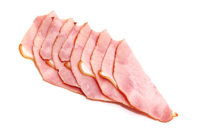2013 Deli Report
Slicing gets versatile




For processors, cleanly sliced proteins mean no tearing, smearing, or frayed and torn edges, in addition to no separation from core binding within the slices. Another key feature of a well-sliced protein is no separation of water from the protein over the shelf life.
Yield also is very important when it comes to slicing.
“The biggest parameter for our company would be the yield measurement, … being able to slice very thinly while maintaining a high yield,” says Justin Siegel, general management at Deli Star Corp.,
Fayetteville, Ill.
A number of slicing technologies are being used to achieve cleanly sliced products, but much of a product’s sliceability is related to its firmness.
“Achieving protein extraction through formula or mechanical action is key,” Siegel explains. “The moisture content, product temperature and age also are factors.”
The quality of the raw meat and whether it is fresh or frozen is the biggest contributor to the quality of the slice and yield, he adds. Land O’Frost believes the definition of “well sliced” is determined by the consumer being targeted.
“Presentation in the package, useability for the consumer and consistency in several areas are all important features in determining a well-sliced protein,” says Bill Marion, vice president of manufacturing at Land O’Frost, Lansing, Ill.
Combining the right product, slicer, blade and package are the means for any successful product in Land O’Frost’s category.
“We’ve learned over the years that all four of these factors should be driven by our consumers’ desires and their end use and not simply fit into the processes we have available on the production floor,” Marion says. “For example, a protein that’s being sliced for a sandwich application may have entirely different features than one being sliced for a salad or other ingredient end use in terms of slice thickness and presentation in the package.”
Challenges to slicing
Consistency is critical in the areas of product formula, size and shape along with the performance of the slicer itself when slicing any protein.
“It’s critical that we start by designing every product formula with the end point in mind and continue that thought process throughout the production system,” Marion says.
Temperature at slicing also is a key factor that impacts the sliceability of the product. “We’ve learned over the years that most products require a minimum residence time for equilibration following blast or brine chilling,” Marion says. “The chilling system itself can affect how long this should take, as will the type of product being sliced. Some products perform better with an additional crust freezing step to stabilize the surface of the log before slicing as well.”
Sliceability also is impacted by other factors at the front end of the process such as moisture and fat-content limits, and the types of ingredients used.
“More highly extended products that are intended for lower cost product lines can present significant challenges if they aren’t formulated with the end use in mind,” Marion says. “Proper binding of fats and proteins in the formulation process will pay great benefits at slicing, but must also be balanced with consideration of the consumer’s preference.”
Many consumer trends such as all natural, organic and lower sodium may eliminate and reduce ingredients that aid in sliceability. For example, sodium phosphate, which is a large contributor to sliceability can be eliminated or reduced to achieve a marketing claim, Siegel says. In addition, if you lower the salt percentage in the formula, the product has a tendency to have higher water activity, making the product more difficult to slice.
Slicing developments
In the last few years, an expansion from predominantly stacked and shingled presentations to include many products that offer a more deli-like fluffed or shaved appearance has occurred. Land O’ Frost’s early successes were built on products that were thinly sliced into shingled portions, Marion says. The presentation allows consumers to match their preference for portion size and slice integrity with a product specifically targeted to accommodate their needs. Building off these products, the company was in the position to develop fluffed and shaved products based on its knowledge of thin slicing, Marion explains.
In 2011, Oscar Mayer introduced Oscar Mayer Carving Board Meats, which uses slicing to make the product especially unique, says Paul Morin, principle engineer, R&D, at Oscar Mayer.
“We slice Carving Board through a patented process that makes the pieces of meat look like they are sliced right off the roast or bird,” he explains. “We like to say the slices are perfectly imperfect. We could slice each piece the same, to fit on a slice of bread, but that’s not how consumers enjoy sliced meat from home.”
To slice Carving Board, Oscar Mayer uses a patented cutting machine that slices the meat so each piece is random. The company’s equipment is not a slicer like in a deli; it’s more of a cutting machine, Morin explains.
“We use customized cutting equipment with a specified set up that allows us to create variation,” he says. “It’s a challenge, as the pieces can’t be too random; in the end, they must all fit into a certain size and weight package.”
Texture also is important with Carving Board meats, Morin explains, so the process is designed to avoid creating a perfectly smooth texture or shiny smooth surface when the meat is sliced.
“We need to tear it a bit, and the end result of this unique slicing is ragged edges,” he adds. “We engineered the Carving Board slicing line to mimic the same action you’d get as if you were carving the meat with a knife in a kitchen.”
In more recent years, Land O’Frost has been encouraged to see the manufacturers of high-speed, slicing equipment focus more on blade technology that specifically addresses slicing different proteins. Slicing equipment manufacturers are using blade angles, blade coatings, blades with serrated edges and different alloys in their manufacturing processes, Marion says. Matching the right blade with the product is a key technique, he says, and blade technology holds great promise for breakthroughs in the future.
Slicing technology also has greatly advanced in the last few years to the point where it’s easier to slice lower quality product with a higher water content.
“It’s a lot easier to wafer slice or thin slice those meats, which greatly improves yield and product quality,” Siegel says.
In regard to food safety, designs that allow operators and sanitors to assemble and disassemble equipment without the use of tools are making it more efficient for manufacturers to execute quick changeovers and reduce the time it takes for sanitation to clean the slicers.
“Bacterial harborage points that have existed for years are being eliminated in these new designs,” Marion says.
In addition to food safety, worker safety and ergonomics breakthroughs are occurring on a regular basis.
“Adherence to the Worker Safety Design guidelines published by the AMI in 2010 and advances in automation will make our processes not only safer for our employees, but more efficient, as well,” Marion says.
Looking for a reprint of this article?
From high-res PDFs to custom plaques, order your copy today!








